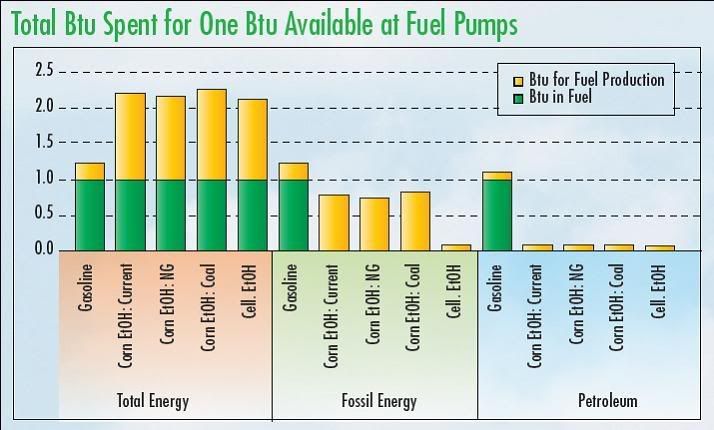
http://www1.eere.energy.gov/vehiclesandfuels/pdfs/program/ethanol_brochure_color.pdf
Posted on 07/08/2008 7:15:41 AM PDT by cassy.kane
I frequently travel through West Texas, eastern New Mexico, and the Oklahoma Panhandle and almost every time I am on an interstate in one of these three areas, I pass a caravan of tractor trailer rigs carrying blades for wind turbines. Wind turbines, which are popping up across the windswept southern plains or the elevated areas of eastern New Mexico, are roughly one hundred feet tall with three blades, each of which are approximately fifty feet long. Moreover, the construction of more of these “environmentally friendly” beasts is constantly pushed by those who believe one above ground oil rig would ruin their view of pristine nature.
In much of these same areas, particularly the Oklahoma Panhandle and West Texas, corn has emerged as a far more prominent crop than it was a decade ago because it is another form of alternative energy: ethanol. The chief purpose of ethanol, not unlike wind energy, is to save the planet by being a cleaner burning fuel for the internal combustion engines in our vehicles. But there is a catch. Just as the individual parts of the wind turbines have to be transported by vehicles that are dependent upon petroleum-derived fuels that cause pollution, it takes 1.3 gallons of gasoline to produce one gallon of ethanol.
Moreover, that one gallon of ethanol that is produced through the burning of 1.3 gallons of gasoline contains one third less energy than a gallon of gasoline, according to Iain Murray, senior fellow at the Competitive Enterprise Institute. This means that by the time you burn 1.3 gallons of ethanol, which is what it takes to equal the energy of a gallon of gasoline, you have actually already burned 1.73 gallons of gasoline simply to produce the cleaner burning 1.3 gallons of ethanol that “replaced” it.
(Excerpt) Read more at humanevents.com ...

http://www1.eere.energy.gov/vehiclesandfuels/pdfs/program/ethanol_brochure_color.pdf
I do. GM, Ford and Chrysler have been hemorrhaging cash for a decade. US Air and United (and others) went into Chapter 11 protection long before the recent run up of oil prices. TWA, PanAm and Eastern Airlines all went belly up with $20 oil.
Both of these industries face fundamental structural and market dilemmas that have nothing to do with the additional burden of energy costs. For the auto industry it is unsupportable legacy costs committed to decades ago with the UAW. For the airline industry, it is the effects of intense price competition and vastly different cost structure between various airlines.
Okay, I need your help.
I can’t figure out from your chart. Does ehtanol use more energy to produce than it makes?
> Increase supply of oil by drilling domestically
This is a good idea. Essentially everywhere it makes economic sense to drill we should be drilling.
It is probably not possible for the USA to become completely independent of oil imports purely by drilling domestically.
It might be possible for the USA to become independent of “shipped” imported oil (continuing imports from Canada and Mexico) if we embarked on a massive coal derived synfuel program.
> Increase energy production in general by building more nukes
This is also a very good idea. Although the USA has not built any new commercial nuclear power plants in decades, the US Navy has plenty of experience. We could be building safe modular reactors on US military bases to power the entire country.
Existing coal power plants could be converted into coal-to-liquids production, once the baseline electrical load is supplied by nuclear power.
The production cost of coal in parts of the USA is dirt cheap - less than $5 per ton. From a BTU equivalent that would be less than $1.50 per barrel of oil. We would not need a strategic petroleum reserve if we had the infrastructure to convert 5 million tons of coal into oil per day.
Disclaimer: Opinions posted on Free Republic are those of the individual posters and do not necessarily represent the opinion of Free Republic or its management. All materials posted herein are protected by copyright law and the exemption for fair use of copyrighted works.